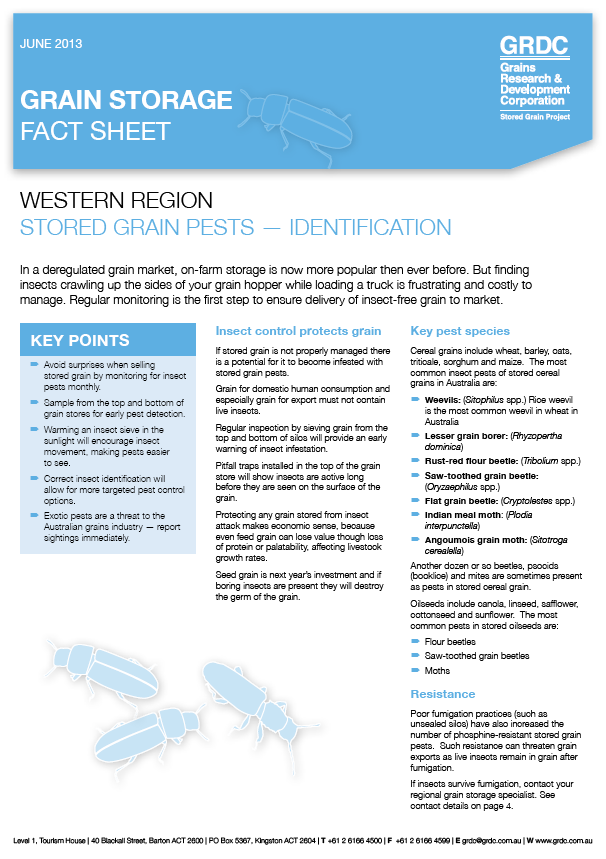Grain Storage Fact Sheet: Stored Grain Pests Identification
Published: 25 Jun 2013

In a deregulated grain market, on-farm storage is now more popular then ever before. But finding insects crawling up the sides of your grain hopper while loading a truck is frustrating and costly to manage. Regular monitoring and correct pest identification are the first steps to ensure delivery of insect-free grain to market.
Key points
- Avoid surprises when selling stored grain by monitoring for insect pests monthly.
- Correct insect identification will allow for more targeted pest control options.
- Sample from the top and bottom of grain stores for early pest detection.
- Warming an insect sieve in the sunlight will encourage insect movement, making pests easier to see.
- Exotic pests are a threat to the Australian grains industry — report sightings immediately.
Insect control protects grain
If stored grain is not properly managed there is a potential for it to become infested with stored grain pests.
Grain for domestic human consumption and especially grain for export must not contain live insects.
Regular inspection by sieving grain from the top and bottom of silos will provide an early warning of insect infestation.
Pitfall traps installed in the top of the grain store will show insects are active long before they are seen on the surface of the grain.
Protecting any grain stored from insect attack makes economic sense, because even feed grain can lose value though loss of protein or palatability, affecting livestock growth rates.
Seed grain is next year’s investment and if boring insects are present they will destroy the germ of the grain.
Why is identification important?
Being able to identify the most common insect pests of stored grain puts growers well ahead when it comes to making the best control decisions.
For example, the lesser grain borer is a serious pest in most regions of Australia, but can now only be reliably controlled with one or two products due to resistance.
So if growers intend applying control treatments they need to know which species are present.
Identification of the particular pest present can highlight a future preventative measure. For example, psocids thrive in warm, humid conditions. Using aeration to lower grain temperature and storing grain at a lower moisture content could prevent a future problem from occurring.
With an increasing number of grain markets requesting reduced chemical residues on grain it is becoming more important to better identify and understand pests. In doing so growers can exploit the best use of both chemical and non-chemical control measures.
As there are limited tools available to control pests in stored oilseeds and pulses, meticulous hygiene, well-managed aeration and regular monitoring is essential.
Want to link to these fact sheets?
Use www.grdc.com.au/GRDC-FS-StoredGrainPestID to ensure your link remains current and up-to-date!
- 425.10 kbGrain Storage Fact Sheet: Stored Grain Pests - Identification (Northern and Southern Regions)In a deregulated grain market, on-farm storage is now more popular then ever before. But finding insects crawling up the sides of your grain hopper while loading a truck is frustrating and costly to manage. Regular monitoring and correct pest identification are the first steps to ensure delivery of insect-free grain to market.
- 423.56 kbGrain Storage Fact Sheet: Stored Grain Pests - Identification (Western Region)In a deregulated grain market, on-farm storage is now more popular then ever before. But finding insects crawling up the sides of your grain hopper while loading a truck is frustrating and costly to manage. Regular monitoring and correct pest identification are the first steps to ensure delivery of insect-free grain to market.
Region: National
Was this page helpful?
YOUR FEEDBACK
